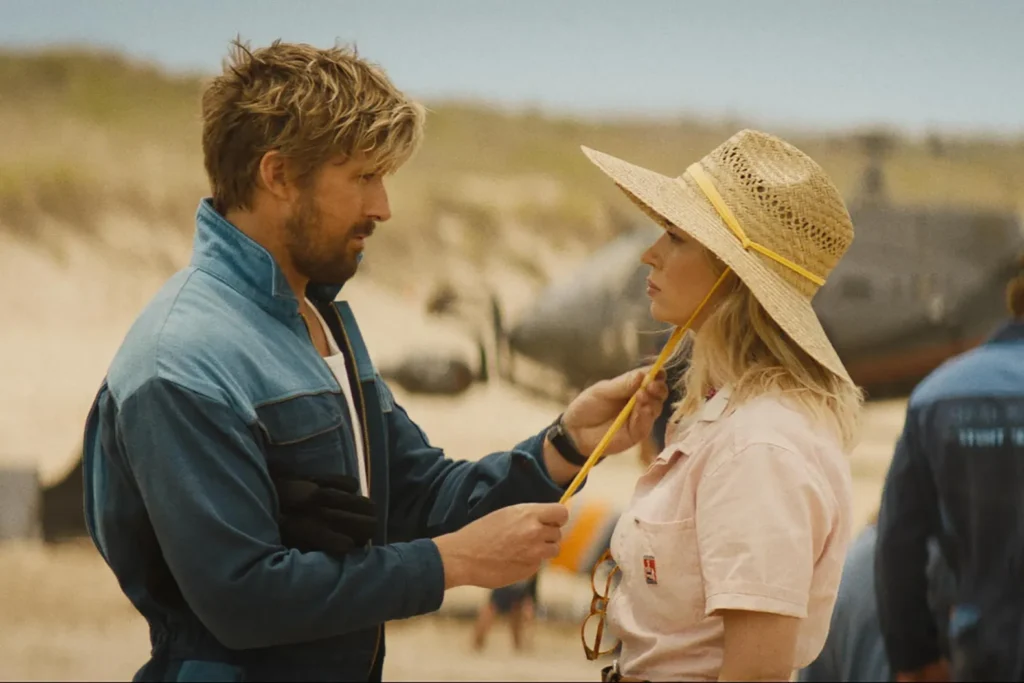From TV Cult Classic to Blockbuster Reboot
The journey of The Fall Guy from a beloved 1980s TV series to a major motion picture is a story of Hollywood nostalgia meeting modern filmmaking ambition. The original show, starring Lee Majors as stuntman Colt Seavers, ran for five seasons from 1981 to 1986, blending action, humor, and a rare behind-the-scenes look at the entertainment industry. What made it unique was its authentic portrayal of stunt work at a time when such professionals received little recognition. Fast forward to 2024, and director David Leitch – a former stuntman himself – has reimagined the property as a big-budget love letter to the unsung heroes of cinema. Ryan Gosling steps into Majors’ boots, bringing his trademark charm and physical comedy to a role that feels tailor-made for his talents. The film cleverly updates the premise while maintaining the spirit of the original, setting its story in today’s Hollywood where practical stunts are increasingly replaced by CGI.
Why This Film Could Change How We See Stunt Performers
At its core, The Fall Guy serves as both entertainment and advocacy for the stunt community. The movie arrives at a pivotal moment in Hollywood, coinciding with the #StuntPerformersMatter movement that’s fighting for Oscars recognition and better working conditions. Gosling and his co-stars underwent intensive training with real stunt coordinators to perform many of their own dangerous sequences, bringing an unprecedented level of authenticity to the action. One particularly groundbreaking aspect is the film’s end credits, which include outtakes of failed stunts – a bold decision that highlights the skill and risk involved in this often invisible profession. The production worked closely with Stunt Unlimited, the industry’s leading stunt organization, to ensure every fall, crash and fight scene met professional standards while pushing creative boundaries.

The Death-Defying Stunts You Have to See to Believe
David Leitch’s insistence on practical effects results in some of the most breathtaking action sequences in recent memory. The film’s showstopper involves a record-breaking eight-and-a-half cannon roll stunt performed by legendary stunt driver Logan Holladay, surpassing the previous Guinness World Record. Another sequence features Gosling performing a 12-story fall through glass panels using a revolutionary new rigging system that allows for mid-air rotation. The car chase scenes utilize cutting-edge pursuit technology developed specifically for the film, including a custom-built camera rig that captures the action from impossible angles. Perhaps most impressive is a single-take fight scene that lasts nearly seven minutes, choreographed by the team behind the John Wick franchise. These aren’t just action beats – they’re arguments for why practical stunts still matter in the digital age.
The Secret Language of Stunts: How They Communicate On Set
One fascinating aspect rarely discussed is the complex communication system stunt teams use during filming. The movie reveals how hand signals, coded phrases, and even specific countdown rhythms help coordinate dangerous sequences without verbal calls that could ruin takes. Gosling had to learn this “stunt sign language” – including subtle eye movements that indicate when a performer is actually in trouble versus acting. The film’s accuracy extends to depicting how safety meetings work, with detailed diagrams of fall zones and impact angles that most movies gloss over. This attention to detail makes The Fall Guy essentially a masterclass in stunt coordination disguised as entertainment.
The Fall Guy A Dynamic Duo for the Ages
The on-screen chemistry between Gosling and Emily Blunt elevates The Fall Guy beyond a standard action flick. Their characters – a disgraced stuntman and the ambitious director who loves him – share a romantic tension that recalls classic Hollywood pairings. Gosling brings layers to what could have been a one-note role, balancing self-deprecating humor with genuine pathos as a man struggling with his place in a changing industry. Blunt, fresh from her Oscar-nominated turn in Oppenheimer, proves equally adept at comedy and action, performing many of her own stunts despite being pregnant during filming. Their reunion after Barbie‘s “I’m Just Ken” musical number shows a playful dynamic that anchors the film’s emotional core. Supporting turns from Winston Duke as a rival stunt coordinator and Stephanie Hsu as a ruthless producer add depth to the ensemble.
The Hidden Economics of Stunt Work Exposed
Beyond the glamour, The Fall Guy pulls back the curtain on the financial realities of stunt performance. A poignant subplot involves Gosling’s character taking dangerous “gag jobs” (one-off stunt work) to pay medical bills from previous injuries. The film accurately portrays how stunt performers typically earn less than 1% of what lead actors make, despite facing equal or greater physical risks. One shocking scene depicts the “stunt pay scale” where performers of color and women receive lower rates for the same work. These revelations have already sparked discussions about union reforms, with the film’s release coinciding with new SAG-AFTRA negotiations on stunt performer compensation.

The Fall Guy Exposes Hollywood’s Dirty Little Secrets
Beneath its glossy surface, The Fall Guy offers surprisingly sharp commentary on the entertainment industry. The plot revolves around a conspiracy involving a missing movie star, allowing for satirical jabs at celebrity culture, studio politics, and the disposable nature of performers. One particularly biting sequence shows how insurance companies dictate creative decisions, while another exposes the dangerous shortcuts some productions take with stunt safety. The film doesn’t shy away from showing the physical toll of stunt work either, with Gosling’s character dealing with chronic pain and the psychological trauma of near-death experiences. These elements transform what could have been mindless entertainment into something more substantive – a rare action movie with something to say.
The Future of Stunts and the Franchise’s Potential
Early screenings suggest The Fall Guy could spark renewed interest in practical action filmmaking. Industry analysts note increased studio interest in stunt-driven projects following the film’s buzz. Universal Pictures is already developing a behind-the-scenes documentary about the making of the stunts, while Leitch has hinted at potential spin-offs exploring different aspects of the stunt world. There’s even talk of an annual “Fall Guy” stunt showcase event that would spotlight exceptional stunt work across the industry. The film’s potential to influence both audiences and the industry itself makes it more than just another summer blockbuster – it could be the start of a new era for how we view and appreciate stunt performance in cinema.
Will The Fall Guy Finally Earn Stunts Academy Recognition?
Perhaps the film’s most significant impact could be on awards season. For decades, stunt professionals have campaigned for an Oscar category recognizing their work. The Fall Guy makes a compelling case by dedicating its post-credits sequence to honoring real-life stunt legends, complete with their résumés of iconic movie moments. The Directors Guild has already announced special screenings to educate voters about stunt coordination. With Gosling and Blunt potentially in the awards conversation for their performances, the film might finally provide the momentum needed to break the Academy’s resistance. If successful, it would mark the first time a movie about stunts actually changed how stunts are honored in Hollywood.
Go to main page


